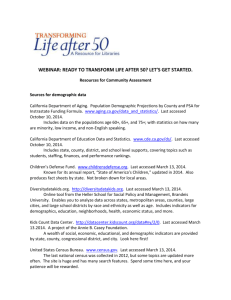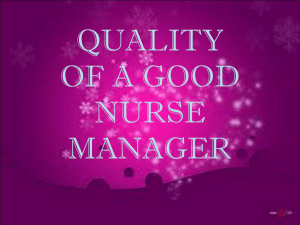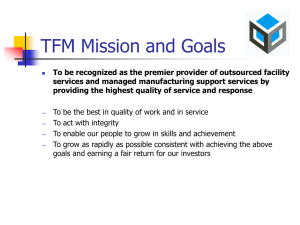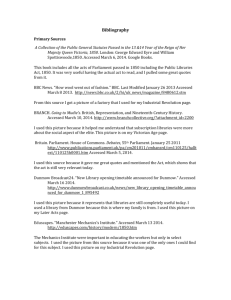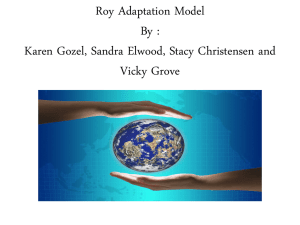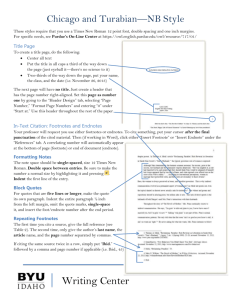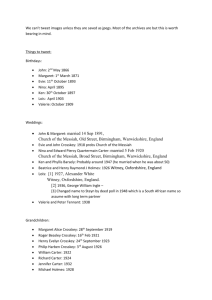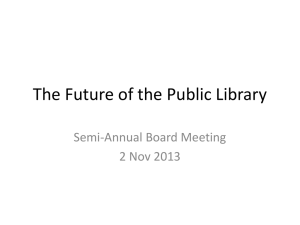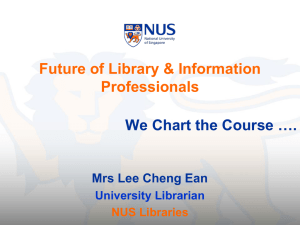Designing a Library Development Plan
advertisement
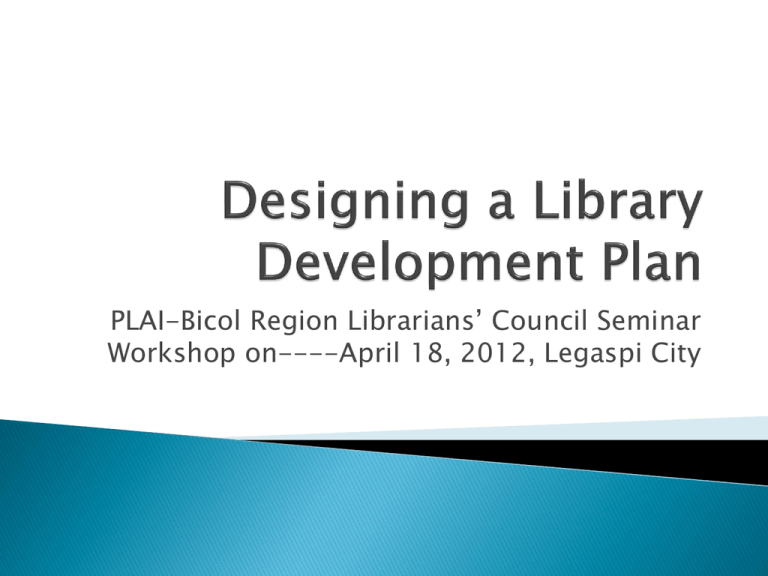
PLAI-Bicol Region Librarians’ Council Seminar Workshop on----April 18, 2012, Legaspi City According to Lesley Barker, eHow Contributing Writer, “… development planning refers to the strategic measurable goals that a person, organization or community plans to meet within a certain amount of time. Usually the development plan includes timebased benchmarks. It generally also includes the criteria that will be used to evaluate whether or not the goals were actually met.” http://www.ehow.com/about_5095844_definiti on-development-planning.html (Accessed April 11,2010) Jan July Oct Dec Future Present (SWOT) (Vision & Goals) (Objectives and Strategies) According to Roy Tennant (2005), “In this world of ubiquitous and fluid content creation and distribution opportunities, only the flexible will survive. Those who can effectively use new modes of communication will be the primary creators of content…and librarians who can make sense of it all on behalf of their clientele will remain treasured assets to society. In such a world, those who thrive on change are king.” Importance of Planning B Future (Goal/Vision) A Present Status Short term Objectives and Strategies Planning enables libraries: ◦ To set direction (vision), develop strategies (action) and monitor progress ◦ To identify strengths and weaknesses of and opportunities and threats to the library. ◦ To identify the needed capabilities (critical success factors) of the library to become successful. ◦ To identify the procedures and practices that need to be changed. Library Staff According to Roy Tennant (2007) Our goal should be: "Get users what they want, when they want, as quickly and painlessly as possible. If we don't do that, we've failed. Our users will go somewhere else.” LIBRARY •Collecti on •Facilitie s •Staff Services Feedback SATISFIED USERS •Parent Institution •Students •Faculty •Staff •General Public Goal: To have a collection that matches the information needs of the library users. Questions to ask? ◦ Is the quality and quantity of our collection satisfactory? ◦ What level of collection quality and quantity should be achieved and maintained? ◦ What performance measure should be used for evaluating the collection? Goal: To have facilities that are appropriate and in quality and quantity to satisfactorily meet the needs of the library users. Questions to ask: ◦ Is the quality and quantity of our facilities satisfactory? ◦ What level of facilities quality and quantity should be achieved and maintained? ◦ What technology will improve the efficiency of library operations? ◦ What performance measure should be used for evaluating the facilities? Goal: To provide the library with the best staff for the services offered by the library. Questions to ask: ◦ Is the level of knowledge and skill of the library staff sufficient to meet the challenge of change? ◦ What staff quality and quantity should be achieved and maintained? ◦ What performance measure should be used for each staff? Goal: To provide the library user with the right information at the right time. Go the Extra Mile and Smile Questions to ask: ◦ Is our level of service satisfactory? ◦ What level of service quality should be achieved and maintained? ◦ What services can we discontinue to reallocate resources? ◦ Who could be our partners outside our boundaries? ◦ What performance measure should be used for each service? What changes in procedures and processes will lead to improved performance? ◦ Goal: To make your collection, facilities and services known to the customers. Questions to ask: ◦ Do our users know what we have? What we can provide? ◦ What promotional strategies should you adapt? ◦ What level of relationship marketing should be achieved and maintained? ◦ What performance measures should be used for each marketing strategy? ◦ Who are my competitors? How do I become competitive? ◦ Where are my users? How can I reach them? ◦ How do I make the library visible? Brainstorm on the following: ◦ Examine the status of your library (SWOT analysis) in terms of collection, facilities, and staff and how it impacts on the users. ◦ Make a vision statement about what you want your library to be in the next three years. ◦ Prepare three SMART (S=specific, M=Measurable, A=Attainable, R=Relevant; T=Time-based (Zahorsky, 2010) goals. One each for the collection, facilities and staff ◦ Think of strategies to reach your goals. Lourdes T. David Director Rizal Library Ateneo de Manila University ltdavid@ateneo.edu lourdesdav@gmail.c om Barker, Lesley. “Definition of Development Planning, ” eHow: How to do just about everything <http://www.ehow.com/about_5095844_definiti on-development-planning.html> (Accessed April 11, 2010) Joseph Matthews (2005). Strategic Planning and Management for Library Managers. Westport, CN: Libraries Unlimited, 2005. Philippine Association of Academic and Research Libraries (PAARL) Standards for academic libraries for 2000. These standards define the qualifications required of library personnel in academic and research libraries in the Philippines. Tennant, Roy (2005) “Roy Tennant Inspires II”. Posted by Michael Stephens in Tame the Web: Libraries, Technology, People. May 2005. http://tametheweb.com/2005/05/17/roy-tennantinspires-ii/ (Accessed April 25, 2010) Tennant, Roy (2007). In SLA Blog posted by Stacey Greenwell. http://slablogger.typepad.com/sla_blog/2007/06/the_o nly_consta.html (Accessed on April 25, 2010) University of California in Los Angeles (UCLA) Library. Administrative Document #700-2: Curricular framework for the learning & development program . (2007). Zahorsky, Darrel (2010) The 5 steps to setting SMART business goals. In About.com: small business information) http://sbinformation.about.com/od/busines smanagemen1/a/businessgoals.htm (Accessed April 25, 2010).

